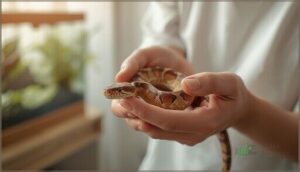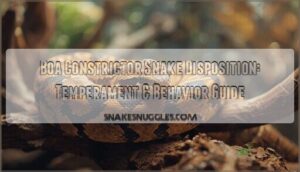This site is supported by our readers. We may earn a commission, at no cost to you, if you purchase through links.
Snakes don’t beg for walks or knock water bowls off counters, but they still need precise care to thrive. A poorly sized enclosure can stress your snake into refusing food for weeks. Wrong humidity levels lead to stuck sheds that damage eyes and scales. Even choosing between frozen and live prey affects your snake’s safety and your own.
Caring for pet snakes means getting the details right from day one. You’ll need to match species to your experience level, build a habitat that mimics their natural environment, and establish feeding routines that keep them healthy without putting them at risk.
When you understand what your snake needs—and why, you create an environment where they can live for decades instead of just surviving.
Table Of Contents
Key Takeaways
- Your snake’s enclosure must match its species-specific needs for size, temperature gradients (75-90°F), and humidity levels (50-75%), since incorrect conditions directly trigger stress, feeding refusal, and shedding complications that damage eyes and scales.
- Frozen-thawed rodents prevent feeding injuries and disease transmission while maintaining full nutritional value, with feeding frequency varying by age—juveniles eat every 5-7 days while adults stretch to 1-2 weeks depending on species.
- Daily waste removal and monthly deep cleaning with a 10% bleach solution are non-negotiable for snake health, as poor substrate management increases multi-drug resistant bacteria by 60% and directly causes respiratory infections.
- Captive-bred snakes from reputable breeders adapt better to handling and live 15-30 years with proper care, but you must verify local ownership laws since many states restrict or ban specific species entirely.
Choosing The Right Pet Snake
Your first snake should be one that thrives in captivity and tolerates handling well. Some species require minimal intervention, while others demand precise humidity levels or specialized diets that can overwhelm new keepers.
Before you bring any snake home, you’ll want to think about temperament, care complexity, and whether your local laws allow you to keep it.
Beginner-friendly Snake Species
Corn snakes are your best starting point—they make up over 40% of beginner purchases thanks to their docile temperament and straightforward care requirements. Ball pythons follow closely, celebrated for their manageable size and stunning python morphs. King snakes offer excellent adaptability across different environments, while rosy boas and garter snakes appeal to owners seeking compact species with simple husbandry and diet needs.
Many beginners find that snakes make great pets if cared for properly.
Avoiding Venomous and High-maintenance Snakes
While corn snakes and ball pythons are ideal starter pets, venomous species pose serious safety risks. Between 2006 and 2015, 31 fatalities resulted from venomous snake exposures in the U.S. At least 19 states ban ownership of venomous snakes entirely.
Large constrictors and tree-dwelling species need expertise most new owners don’t have. Many owners are misinformed about pet snake needs.
Stick with beginner-friendly options—your safety depends on it.
Sourcing Snakes From Reputable Breeders
Once you’ve chosen your species, find a reputable breeder who maintains welfare standards and ethical breeding practices. Over 75% of pet snakes are now captive-bred, which protects wild populations and produces healthier animals.
Look for breeders offering health guarantees, certificates with hatch dates, and detailed feeding records. Ask about genetic diversity in their breeding lines. Captive-bred snakes adapt better to handling and have fewer stress-related illnesses than wild-caught specimens.
Legal Considerations and Permit Requirements
Before buying your snake, check state and local ordinances. Species restrictions vary widely—Maryland bans all venomous snakes, while Colorado requires breeder licensing for native species like king snakes. Some regions prohibit giant snakes or specific breeds altogether.
If you already own restricted exotic pets, look into ownership grandfathering options before deadlines pass. Interstate transport rules also differ, so verify regulations for both reptile ownership and your chosen snake species.
Setting Up a Proper Snake Habitat
Your snake’s home is the foundation of its health and well-being. Getting the setup right from the start prevents stress and illness down the road.
Here’s what you need to create a safe and comfortable habitat for your snake.
Selecting The Right Terrarium Size
Your snake’s terrarium size directly impacts its health and behavior. Minimum size should match your species’ needs: terrestrial snakes require an enclosure length equal to their body length, with a width at half their length.
Larger snake enclosures promote natural stretching and activity. Use sizing formulas as starting points, then upgrade frequently as your snake grows.
Proper tank size prevents stress and fosters long-term wellness in your snake habitat setup.
Essential Enclosure Features and Security
Beyond size, your snake enclosure requires features that prevent escapes and maintain a stable snake environment. Locking mechanisms are critical—double-lock systems eliminate escapes entirely. Prioritize these three elements:
- Escape-proof materials: Use mesh with gaps under 0.25 inches and silicone-sealed edges.
- Ventilation controls: Position adjustable vents on opposite sides for cross-airflow.
- Structural maintenance: Inspect seals and locks weekly to catch vulnerabilities early.
Bedding and Substrate Options
Your snake’s substrate choice directly impacts humidity control and overall health in the snake enclosure. Aspen vs cypress becomes critical here—aspen works well for dry-climate species at 30-50% humidity, while cypress maintains moisture above 50% for tropical snakes. Avoid cedar and sand entirely due to respiratory and impaction risks.
Bioactive substrates like coconut fiber suit high-humidity snake habitats but generate more dust.
Cost analysis favors aspen for budget-conscious keepers.
Temperature, Humidity, and Lighting Requirements
Think of your snake’s enclosure as a climate control system—thermal gradients, humidity levels, and lighting cycles work together for proper thermoregulation.
Corn snakes need 75°F to 85°F with a 90°F basking spot, while ball pythons prefer 87°F warm sides.
Maintain 50-75% humidity control using a digital hygrometer. Provide 12-hour lighting cycles with your heating source.
Incorrect conditions trigger stress and illness.
Providing Water and Hiding Spots
Your snake’s survival depends on two non-negotiables: fresh water and proper hiding spots. Replace water every 24 hours in a shallow dish large enough for soaking—room temperature (20–24°C) prevents thermal shock. Use conditioned tap or spring water; distilled water causes mineral imbalances.
- Install two snug-fitting hides: one warm side, one cool side
- Monitor hydration signs: wrinkled skin signals dehydration
- Maintain 50-75% humidity for healthy shedding
- Make sure hides fit securely for stress reduction
- Check water temperature daily for mineral balance
Missing hides increase stress hormones and trigger feeding problems.
Feeding and Nutrition for Pet Snakes
Feeding your snake the right way keeps them healthy and prevents serious problems down the road. You need to know what to feed, how often to feed, and how to spot when something’s off.
Let’s cover the essentials of snake nutrition so you can get feeding right from the start.
Choosing Appropriate Prey Types and Sizes
Getting your snake’s food right means understanding that prey type, size, and source all matter for their health. Rodents like mice and rats form the foundation of most snake diets, but some species need avian options like chicks for proper nutrition.
Your snake’s prey should measure 1–1.5 times the width of their thickest body part to prevent injury and regurgitation. Frozen rodents reduce parasites compared to wild-caught options.
Safe Feeding Practices (frozen-thawed Vs. Live)
Once you’ve selected the right prey size, how you present it matters just as much. Frozen-thawed rodents are the preferred method in snake feeding—they prevent feeding injuries and disease transmission while maintaining full nutritional value. Here’s why veterinarians recommend this approach for your snake’s diet:
- Feeding injuries drop dramatically: Live prey can bite or scratch your snake, causing wounds that need veterinary care
- Disease transmission risks decrease: Frozen rodents eliminate most parasites and bacterial threats found in live feeders
- Nutritional value stays intact: Properly stored frozen rodents retain over 95% of nutrients for months
- Behavioral adaptation succeeds easily: Over 80% of snakes switch to frozen-thawed prey within weeks
- Cost comparison favors frozen: You’ll save 30–40% compared to buying live rodents weekly
Snake safety improves when you thaw prey in warm water and present it with tongs. This mimics natural movement without the dangers of live feeding.
Feeding Schedules by Age and Species
Your snake’s age and species determine how often you’ll feed. Juvenile ball pythons need meals every 5–7 days, while adults stretch to every 1–2 weeks. Corn snakes follow similar juvenile feeding patterns, but adult intervals vary—7–10 days is typical. Species variation matters: king snakes often wait 10–14 days as adults.
Seasonal adjustments and weight monitoring help you fine-tune this snake feeding schedule year-round.
Monitoring Feeding Behavior and Appetite
Beyond scheduling meals, you’ll need to read your snake’s actual interest. Hunger signs include rapid tongue flicking and focused tracking near the enclosure—both signal your snake’s ready to eat.
Watch for appetite decline lasting over four weeks or post-feeding behavior like reduced movement, which helps confirm healthy digestion. Overfeeding signs such as visible fat deposits tell you it’s time to adjust handling behaviors and your snake feeding schedule.
Maintaining Snake Health and Hygiene
A healthy snake depends on consistent monitoring and clean living conditions. You need to watch for early warning signs of illness, maintain proper hygiene in the enclosure, and know when professional veterinary care is necessary.
Let’s cover the essential health practices that keep your snake thriving.
Recognizing Signs of Illness and Stress
Your snake won’t always tell you when something’s wrong—but it will show you. Loss of appetite is the first red flag in over 75% of sick snakes. Watch for breathing issues like wheezing or mouth bubbles. Behavioral changes, physical symptoms like skin lesions, and stress indicators such as constant hiding all point to trouble.
Early snake health monitoring helps you catch snake diseases before they become serious, making veterinary care more effective.
Regular Veterinary Care for Snakes
Even healthy snakes need annual veterinary care from an exotic animal veterinarian. Only 21% of owners currently schedule routine checkups, yet these visits catch issues early through physical exams, fecal screenings, and husbandry reviews.
Standard vet visit frequency should be yearly, costing $80–$120 per appointment. Parasite detection matters—28.5% of snakes test positive for hidden infections.
Consider exotic pet insurance starting at $21 monthly to improve owner compliance with snake health recommendations.
Assisting With Shedding and Skin Health
During the snake shedding process, your pet will shed 3–5 times yearly as adults. Humidity control at 70–80% prevents retained eyecaps and skin infections. Watch for dull coloration signaling shedding time. Provide rough surfaces for aiding shedding.
Incomplete sheds indicate snake health issues like dehydration. Check post-shed for retained skin on tail tips. Proper shedding frequency and environmental adjustments maintain prime snake health.
Cleaning and Disinfecting The Enclosure
Through routine maintenance, you’ll protect your snake’s health and prevent disease outbreaks. Snake hygiene depends on consistent cleaning frequency and proper disinfectant efficacy to eliminate harmful pathogens in the snake enclosure.
- Remove waste daily and replace water bowls to reduce bacterial load
- Deep clean every 2-4 weeks with 10% bleach solution for maximum disinfectant efficacy
- Replace all substrate monthly since 92% of contamination originates there
- Rinse surfaces thoroughly after disinfecting to guarantee snake safety
- Monitor cleaning frequency closely—monthly cycles increase multi-drug resistant bacteria by 60%
Poor substrate management and infrequent cleaning directly compromise snake health through respiratory infections and opportunistic bacterial growth. Always follow safety precautions by wearing gloves and guaranteeing complete drying before returning your snake to its habitat.
Safe Handling and Interaction Tips
Handling your snake properly protects both of you from injury and stress. The way you approach and hold your snake affects its comfort level and your safety.
Follow these guidelines to create positive interactions while maintaining good hygiene practices.
Proper Handling Techniques for Snakes
Handling your snake safely starts with proper support—always use two hands to cradle both the head and midbody simultaneously. This technique cuts escape attempts by over half and protects your snake’s spine.
For venomous or difficult species, tools like hooks maintain a safe distance and reduce bite risk by 79%.
Always wash your hands before and after contact to prevent disease transmission between you and your pet.
Reducing Stress During Handling
Stress shows up fast when snake handling techniques ignore your pet’s comfort. Keep sessions under 10 minutes—longer handling duration spikes stress hormones by 44%. Follow these proven strategies:
- Handle weekly on a predictable schedule to reduce defensive behavior by one-third
- Maintain ideal enclosure humidity above 75% to lower visible stress signs
- Guarantee proper temperature impact—substandard warmth raises stress markers by 32%
- Try social buffering with companion snakes to cut heart rate changes by 35%
- Provide adequate shelter before handling to prevent escape responses
Your snake’s behavior tells you everything about handling frequency and timing.
Hygiene Practices to Prevent Disease Transmission
Your hands are the bridge between your snake and every surface in your home. Wash with soap for at least 20 seconds after handling your pet or touching anything in its enclosure—this simple step cuts Salmonella risk dramatically.
Never clean snake items near kitchens. Disinfect the enclosure weekly using diluted bleach, letting it sit 15 minutes before rinsing thoroughly.
Bonding and Enrichment Activities for Snakes
Beyond hygiene, enrichment actually reshapes your snake’s brain. Studies show enriched environments increase brain volume and foraging efficiency while lowering stress hormones. Rotate hiding spots, add climbing branches, or introduce new scents weekly—these activities improve cognitive impact and movement rates.
Enrichment reshapes your snake’s brain—rotate hiding spots, add climbing branches, and introduce new scents weekly to boost cognition and lower stress
Corn snakes and ball pythons recognize your scent over time, becoming calmer with regular, gentle handling. Understanding snake behavior through enrichment strengthens your bond naturally.
Frequently Asked Questions (FAQs)
Can snakes recognize their owners over time?
Studies show 70% of captive snakes recognize their owner’s hand by week four. Recognition mechanisms include scent and voice conditioning.
Species differences exist—boas learn faster than colubrids, improving handling protocols and enrichment strategies.
How do snakes communicate with each other?
Snakes communicate through pheromone signaling, tactile communication, visual displays, and auditory response. Understanding snake behavior reveals complex social networks where chemical cues, body contact, and defensive postures create enrichment-driven interactions across snake species.
Do snakes need companionship or prefer solitude?
Unlike cats or dogs, most pet snakes are loners by nature. While some species tolerate group living in the wild, forced cohabitation risks stress, aggression, and health problems in captivity.
What sounds or noises do snakes make?
Most snakes hiss as a warning, producing sounds between 3,000 and 13,000 Hz. Rattlesnakes increase their rattle frequency when threatened. Some species create unique bellowing or scale-rubbing sounds during defensive encounters.
How long do pet snakes typically live?
Like a well-tended garden, your snake’s lifespan depends on the care you provide. In captivity, most pet snakes live 15 to 30 years—far outlasting their wild counterparts—with proper diet, habitat, and veterinary care.
Conclusion
Picture your snake coiled comfortably under its heat lamp, shedding cleanly in one piece, and striking pre-killed prey without hesitation. That’s what proper care looks like.
Caring for pet snakes isn’t guesswork—it’s precision. Get the habitat right. Feed safely. Watch for health changes.
When you commit to these fundamentals, your snake won’t just survive in captivity. It’ll thrive for decades, becoming a reliable companion that asks for little but deserves your best effort every single day.
- https://www.kwikpets.com/blogs/reptiles/common-snake-species-that-are-generally-kept-as-pets
- https://www.petmd.com/reptile/ball-python-care-sheet
- https://petadvocacy.org/wp-content/uploads/2022/01/Snakes-Care-Sheet.pdf
- https://phys.org/news/2022-07-potential-welfare-privately-snakes.html
- https://www.cambridge.org/core/journals/animal-welfare/article/survey-exploring-the-impact-of-housing-and-husbandry-on-pet-snake-welfare/7BED1DBAF7E7736788E3DEDAAC2A352D















